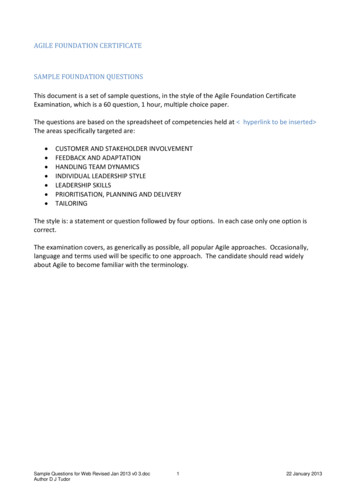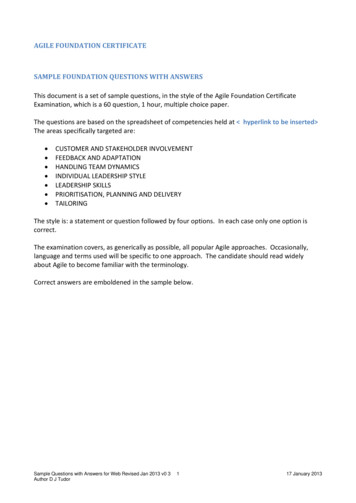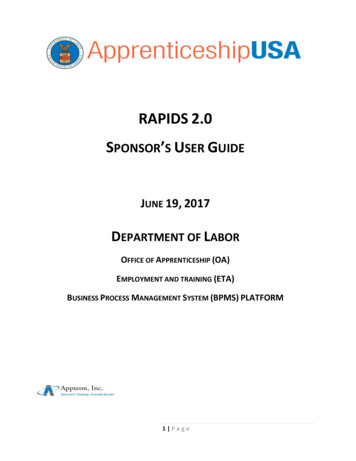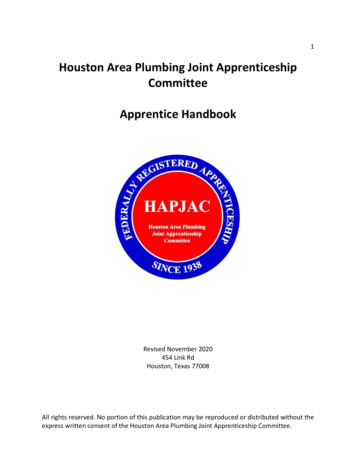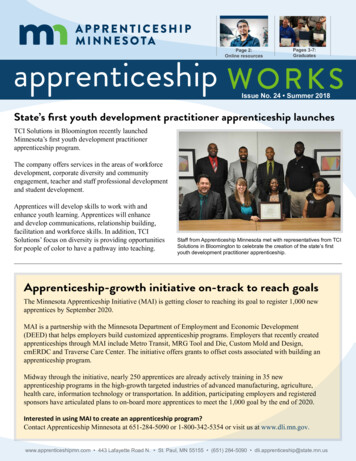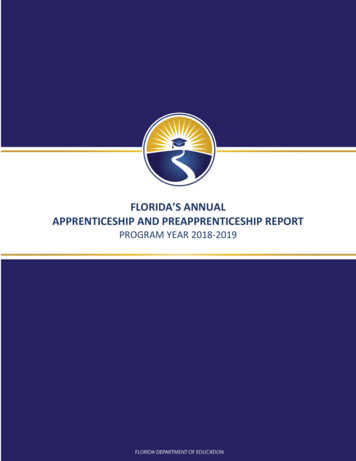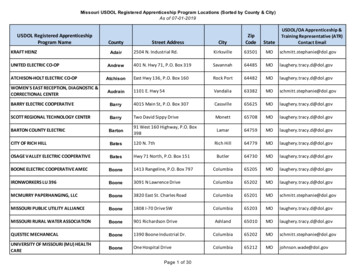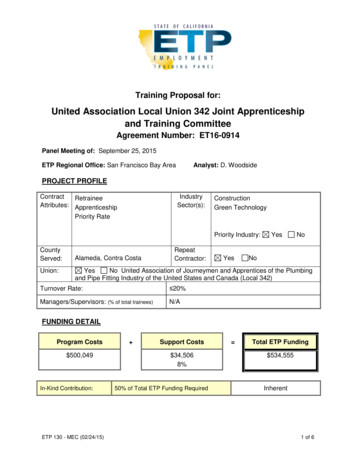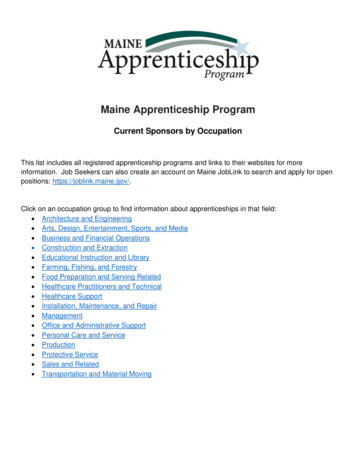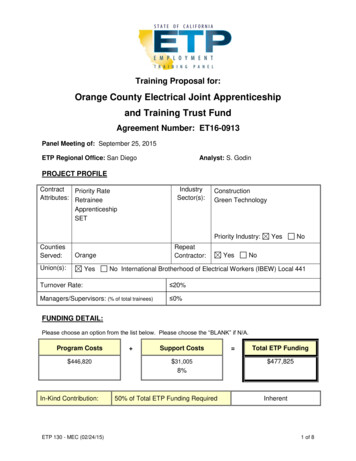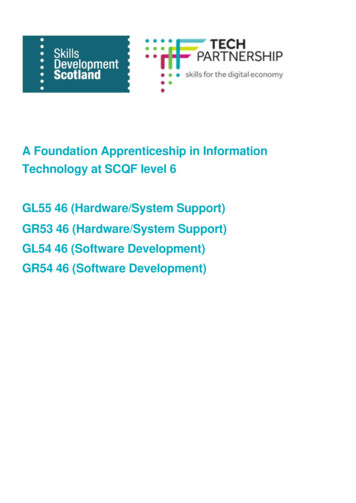
Transcription
A Foundation Apprenticeship in InformationTechnology at SCQF level 6GL55 46 (Hardware/System Support)GR53 46 (Hardware/System Support)GL54 46 (Software Development)GR54 46 (Software Development)
Date ApprovedOctober 2020Review DateEnd DateVersion1.0This document provides you with information you will require to deliver a FoundationApprenticeship in Information Technology.If you need any further information please contactTony.Venus@thetechpartnership.comVersion ControlVersion Number1.0Revision(s)Approved byNew Framework Frank QuinnSpecificationpostFAdevelopmentsDateOctober 20202
BackgroundOne of the key recommendations of Sir Ian Wood’s review on developing the young workforcewas to “develop better connectivity and co-operation between education and the world of workto ensure young people at all levels of education understand the expectations of employers,and that employers are properly engaged” (Scottish Government response to “Developing theYoung Workforce; 2015). The Scottish Government set ambitious targets to ensure thisconnectivity is delivered through a partnership of schools, colleges/training providers andemployers.Skills Development Scotland (SDS), alongside other partners, is working with industry to increasethe range of work-based learning opportunities for pupils in the senior phase of secondary schools.One of the ways this is being achieved is through the development of Foundation Apprenticeshipsand SDS is leading this initiative. Foundation Apprenticeships will allow pupils to gain vocationalqualifications that combine sector specific skills alongside the knowledge that underpins theseskills in a workplace setting while still at school.The Foundation Apprenticeship in Information Technology is designed to provide S5 and S6 pupilsopportunities to develop skills and knowledge for entry into a career in the IT sector. It alsocontributes directly to achievement of the Modern Apprenticeship in IT and Telecoms by attainmentof the core units of the MA qualification.The Information Technology sector in ScotlandThere are more than 7,000 workplaces in Scotland’s IT & Telecoms industry – 84% of which areIT and 16% Telecoms. 89% of these are services orientated. Though micro firms make up 92% ofthe number of IT & Telecoms workplaces in Scotland, they employ just 25% of the sectorworkforce. By contrast, companies with 200 or more employees make up less than 1% of thenumber of workplaces but employ the largest proportion (37%) of the workforce.In terms of its workforce, there are 100,000 people (or one in every twenty fifth person working inScotland) employed in IT & Telecoms – 56,000 (56%) of which work in the IT & Telecoms industryitself with a further 44,000 (44%) working as IT or Telecoms professionals in other industries.In Scotland, nearly two fifths (38%) of IT & Telecoms professionals work in software roles, andover the last decade the number of software professionals has grown by over a half (56%).Why choose Information Technology?Scotland is highly dependent on its IT & Telecoms workforce – it underpins the economy and isintegral to information, business and consumer services, health and leisure and modern day socialnetworking. Across all industries in Scotland it is the combination of its highly skilled IT & Telecomsprofessionals, technology-savvy business leaders and competent IT users that enable theirorganisations’ effective participation in the global digital economy.Currently the IT & Telecoms industry contributes in excess of 3 billion or 3% of Scotland’s totalGross Value Added (GVA). Optimisation of the use of IT & Telecoms by businesses could generatean additional 3.7bn GVA to the Scottish economy over the next 5 to 7 years. It is estimated thatthis GVA uplift could translate into 39,000 new jobs, across many occupations and sectors, overthe next 5 to 7 years.3
The IT industry covers a wide range of job roles such as: IT Technical SupportSoftware Developer (including Apps and Games)Web DeveloperDatabase AdministratorInformation (including Cyber) SecurityWhat is the Foundation Apprenticeship in Information Technology?The Foundation Apprenticeship (FA) in Information Technology is for pupils in S5 and S6 andtypically takes 2 years to complete. Increasingly the framework is also available over a shorterduration, typically a single academic year.Irrespective of the delivery model, the Information Technology framework includes three coreelements, namely:1. National Progression Award in Information Technology2. Work Based Challenge Unit3. Work Based Learning unitsPupils complete one of two National Progression Awards (NPA) at SCQF level 6, dependingon their chosen pathway. There are two available pathways covering the main clusters of jobroles in the IT sector: Pathway 1: Hardware / System SupportNPA in Professional Computer Fundamentals Pathway 2: Software DevelopmentNPA in Software DevelopmentThe full programme specification is outlined further in this document.Background / rationaleThis Foundation Apprenticeship supports the commitment to provide relevant work-basedvocational education and training as part of the senior phase curriculum. This will prepareyoung people for direct entry into a career in the IT sector by equipping them with thenecessary skills and knowledge to work effectively from day one of employment. This includesboth the development of practical and technical skills alongside the development of learnermeta-skills, supported via project-based learning. It also highlights meaningful vocationalpathways as challenging and valuable alternatives to existing academic subjects.PartnershipA Foundation Apprenticeship is about the right balance between delivering the taught elementsof the programme (the NPA) and the development of work-based competences the meta-skillsand work-based learning elements.Development of true competence depends on the continuing acquisition and application ofunderpinning skills and knowledge. Young people need to build real workplace skills includingboth those that are specialist to the chosen career and the generic behaviours and attributes4
that apply to any workplace. This is achieved in a real work setting involving meaningfulactivities introduced throughout the programme.Foundation Apprenticeships are delivered by partnerships comprised of school, learning providerand employer. The learning provider is responsible for the approvals, delivery, assessment andquality assurance of the component units and qualifications. Where multiple learning providers areinvolved, arrangements between them will be detailed in an SQA Partnership Agreement.The learning provider must have the appropriate SQA centre and qualification approvals in placebefore it can deliver the Foundation Apprenticeship.For further support and guidance on SQA’s approval, quality assurance processes and SQAPartnership Agreements, please see:https://www.sqa.org.uk/sqa/79474.htmlEmployers are an essential part of the partnership and can contribute in a range of ways, fromcreating a workplace challenge, to coaching and mentoring, to interviewing and selection. Theymay also be involved in the assessment of the work-based learning element.Pastoral CareThe young people embarking on this Foundation Apprenticeship are school pupils andtherefore all those involved in delivering the programme have a duty of care. This includesproviding appropriate health and safety training and measures to ensure the safety of theyoung people, including relevant safeguarding requirements that are required by respectiveLocal Authority and School partners. This must be in the context of the specific workplaces ofthe individual pupils (one of the mandatory units of the FA covers health and safety).In addition, a workplace mentor must be assigned to be a point of contact for the young personwhen they are not in the school environment.Work placement allocation and methodology, whether on-site or through remote working,should take cognisance of the learner’s personal circumstances to maximise the learnerexperience and opportunity.How should the Foundation Apprenticeship in Information Technology be delivered?Often, delivery and assessment of the relevant NPA occurs at the start of the programme sothat the underpinning knowledge can be obtained before contextualising within the work-basedlearning element.The work-based challenge unit is designed to support the contextualisation of the NationalProgression Award, and therefore should be seen as a complementary unit to run concurrentwith the NPA.The work-based learning element is designed to offer the learning access to the workplace,either physically onsite or through remote working. Learning providers are required to identifyhost employer(s) to provide the work placement opportunity. Employer(s) are asked to providereal work activity aligned to the organisations objectives and to support the development ofevidence for assessment against the outcomes5
Involvement of industry is encouraged across the entire programme of learning. Learnersuccess is best reflected when the delivery of the theory and practical elements are aligned.This approach maximises the contextualisation for the learner and offers the opportunity to putinto practice underpinning learning.Work Based Challenge Unit/Meta-skills:The WBCU set at SCQF L6 has been designed to support the delivery of the NPA. Providersare asked to engage with employer(s) to identify a suitable project that will complement thelearning outcomes within the NPA units.Incorporated within the WBCU is a meta-skills framework designed to emphasise theimportance of meta-skills to industry in addition to technical and practical ability. Through theproject associated with the WBCU, learners are required to understand meta-skills andconsider which they are likely to develop through their role in the project. Reflective practiceis central to the development meta-skills throughout the project. Learners are asked to reflecton their meta-skills development and record this alongside their evidence base.For further information on the WBCU and meta-skills, please refer to the link provided at theend of this document.Work Based learning Element:The Information Technology FA contains units aligned to the respective modern apprenticeshipprogrammes. Providers are encouraged to utilise the SVQ route where physical access to theworkplace remains and assess in accordance to the SVQ assessment standards required forexternal verification. Where not possible, providers may utilise the corresponding customisedunit. This reflects the same content and standards underpinned by the NOS however offersgreater flexibility to the methods of deliver and assessment where access to the physicalworkplace is not available.It is acceptable that learners may achieve the Foundation Apprenticeship via a blend of SVQor Customised units. However, it is critical that irrespective of the route taken, all evidencegathered is mapped to the respective performance criteria and to the standards required of theexternal verification.Please refer to the Foundation Apprenticeship Product Specification for further information on theprinciples of Foundation Apprenticeship delivery.Please refer to the Annex’s at the end of this document for a detailed breakdown of the units and codeswithin the framework(s) Annex 1:Annex 2:Annex 3:Annex 4:FA IT Hardware/Systems Support 2019 commencementFA IT Hardware/Systems Support 2020 commencementFA IT Software Development 2019 commencementFA IT Software Development 2020 commencement6
CertificationSQA will issue the commemorative certificate for the Foundation Apprenticeship.Learning providers must ensure that they have appropriate approvals in place with SQA for theFoundation Apprenticeship and all mandatory components. Candidates must be entered andresulted for all relevant units for verification and certification purposes.Once all contributing results are entered on SQA systems, the candidate’s commemorativecertificate will be produced.SQA Awarding Body quality assurance requirements apply to the delivery of the SQA componentunits and group awards. Centres are required to sign up to the relevant Assessment Strategy forthe SVQ and comply with all its requirements.Information Technology placements for the Foundation ApprenticeshipPlacements for pupils undertaking a Foundation Apprenticeship in Information Technologyshould provide the opportunity either to: Have significant input to a long-term project involving requirements gathering, design,development and implementation phases such as the development of a softwareapplication or web site; Contribute to the systematic investigation of reported faults or incidents, anddetermination of solutions involving a range of IT systems.orLearner Selection and Entry RequirementsThe Foundation Apprenticeships in Information Technology are aimed at pupils with an interestand enthusiasm in exploring this area of work. Although set at SCQF L6, due to thecontextualised learning experience where underpinning theory and practice are aligned withindustry, learners operating at SCQF L5 or above on arrival are encouraged.EqualitiesWe expect those involved in the development, recruitment and delivery of FoundationApprenticeships to be pro-active in ensuring that no-one should be denied opportunitiesbecause of their age, disability, gender reassignment, marriage and civil partnership, religionor belief, sex or sexual orientation or pregnancy and that any barriers (real or perceived) areaddressed to support all pupils. These are the protected characteristics of the Equality Act2010 and training providers and employers must comply with this Act to ensure that applicantsare not discriminated against in terms of entry to and promotion within the industry.Our emphasis throughout is upon equality and diversity both for new entrants to the sectorand opportunities for progression for the existing workforce.7
Learner ProgressionFoundation Apprenticeships are directly aligned to three primary progression pathways. Theseare: Modern ApprenticeshipFurther EducationHigher EducationModern Apprenticeship:A pupil completing the Foundation Apprenticeship in Information Technology will haveachieved a large proportion of the requirements for a Modern Apprenticeship in IT andTelecoms Modern Apprenticeship at SCQF level 6.Further Education:All Scottish further education colleges recognise the Foundation Apprenticeship in IT as aneligible qualification towards Higher National provision, alongside other qualifications.Higher Education:Scottish universities recognise the Foundation Apprenticeship in Information Technology asan eligible qualification towards under-graduate degrees and graduate apprenticeshipprovision, alongside other qualifications.Recognition of Prior LearningSQA’s policy is to recognise prior learning as a method of assessing whether a learner’sexperience and achievements meet the evidence requirements (i.e. the standard) of a SQAUnit or Units and which may or may not have been developed through a course of learning.More information can be found on the SQA website8
Annex 1:Entrants in 2019 should following this qualification framework:Structure of the Foundation Apprenticeship in InformationTechnology: Hardware/System SupportGL55 46 Foundation Apprenticeship in Information Technology: Hardware/ System Support(finishes July 2021)SCQFCreditpointsGroup Award Title Unit TitleSCQF levelGG0F 46NPA inProfessionalComputerFundamentalsH2N5 12Security Fundamentals66H2N6 12Network Fundamentals66H2N7 12Server Administration Fundamentals66H3C4 04Personal Effectiveness 2ORCustomised unit – J4ER 04Personal Effectiveness 2ORJ4YL 04Work Based Challenge966Work BasedLearningH3C5 04Health and Safety in IT & TelecomORCustomised unit - J4ES 04Health and Safety in IT & Telecom41H39S 04IT & Telecom System Operation 2ORCustomised unit - J4ET 04IT & Telecom System Operation 2612H3AV 04Testing IT & Telecom Systems 2ORCustomised unit - J4EN 04Testing IT & Telecom Systems 261257H3B5 04Working with IT & TelecomsHardware and Equipment 1ORCustomised unit - J4EP 04Working with IT & TelecomsHardware and Equipment 19
FoundationApprenticeshipCertification UnitHE6E 04Foundation ApprenticeshipCertificationTOTAL SCQF CREDIT POINTS-056 or 5910
Annex 2:Entrants in 2020 should following this qualification framework:Structure of the Foundation Apprenticeship in InformationTechnology: Hardware/System SupportGR53 46 Foundation Apprenticeship in Information Technology: Hardware/ System SupportGroup Award TitleGG0F 46NPA inProfessionalComputerFundamentalsWork BasedLearningUnit TitleSCQFCredit pointsH2N5 12Security Fundamentals66H2N6 12Network Fundamentals66H2N7 12Server Administration Fundamentals66J4YL 04Work Based Challenge66H3C5 04Health and Safety in IT & TelecomORCustomised unit - J4ES 04Health and Safety in IT & Telecom41H39S 04IT & Telecom System Operation 2ORCustomised unit - J4ET 04IT & Telecom System Operation 2612H3AV 04Testing IT & Telecom Systems 2ORCustomised unit - J4EN 04Testing IT & Telecom Systems 261257-0H3B5 04Working with IT & Telecoms Hardwareand Equipment 1ORCustomised unit - J4EP 04Working with IT & Telecoms Hardwareand Equipment 1FoundationApprenticeshipCertification UnitSCQFlevelHE6E 04Foundation Apprenticeship Certification11
TOTAL SCQF CREDIT POINTS56One SCQF credit point is equivalent to 10 notional hours of learning.12
Annex 3:Entrants in 2019 should follow the below qualifications framework:Structure of the Foundation Apprenticeship in InformationTechnology: Software DevelopmentGL54 46 Foundation Apprenticeship in Information Technology:Software Development(finishes July 2021)Group AwardUnit TitleTitleSCQF levelGL4W 46NPA in SoftwareDevelopmentH6S9 46Computing: ApplicationsDevelopmentF3T2 12Computing: Authoring a WebsiteJ27C 76Software Design and DevelopmentH3C4 04Personal Effectiveness 2ORCustomised unit – J4ER 04Personal Effectiveness 2Work BasedLearningORJ4YL 04Work Based ChallengeH3C5 04Health and Safety in IT & TelecomORCustomised unit - J4ES 04Health and Safety in IT & TelecomH3AH 04Investigating and Defining CustomerRequirements for IT & TelecomsSystems 2ORCustomised unit - J4EY 04Investigating and Defining CustomerRequirements for IT & TelecomsSystems 2H3BA 04Data Modelling 1ORCustomised unit - J4F0 04Data Modelling 1SCQFCreditPoints6666699664161254612one fromH3A4 04Event Driven Computer Programming2ORCustomised unit - J4EV 0413
Event Driven Computer Programming2FoundationApprenticeshipCertification UnitH3AE 04Procedural Programming 2ORCustomised unit - J4EX 04Procedural Programming 26H3AB 04Object Oriented ComputerProgramming 2ORCustomised unit - J4EW 04Object Oriented ComputerProgramming 26HE6E 04Foundation ApprenticeshipCertification-TOTAL SCQF CREDIT POINTS056 or 5914
Annex 4:Entrants in 2020 should follow the below qualifications framework:Structure of the Foundation Apprenticeship in InformationTechnology: Software DevelopmentGR54 46 Foundation Apprenticeship in Information Technology:Software DevelopmentGroup Award Title Unit TitleSCQFlevelGL4W 46NPA in SoftwareDevelopmentH6S9 46Computing: Applications Development66F3T2 12Computing: Authoring a Website666966J27C 76Software Design and DevelopmentWork BasedLearningSCQFCreditPointsJ4YL 04Work Based ChallengeH3C5 04Health and Safety in IT & TelecomORCustomised unit - J4ES 04Health and Safety in IT & TelecomH3AH 04Investigating and Defining CustomerRequirements for IT & Telecoms Systems2ORCustmised unit - J4EY 04Investigating and Defining CustomerRequirements for IT & Telecoms Systems2H3BA 04Data Modelling 1ORCustomised unit - J4F0 04Data Modelling 14161254612one fromH3A4 04Event Driven Computer Programming 2ORCustomised unit - J4EV 04Event Driven Computer Programming 215
FoundationApprenticeshipCertification UnitH3AE 04Procedural Programming 2ORCustomised unit - J4EX 04Procedural Programming 26H3AB 04Object Oriented Co
The Foundation Apprenticeship (FA) in Information Technology is for pupils in S5 and S6 and typically takes 2 years to complete. Increasingly the framework is also available over a shorter duration, typically a single academic year. Irrespective of the delivery model, the Information Technology
